Read Reviews
The Best Wood Moisture Meters
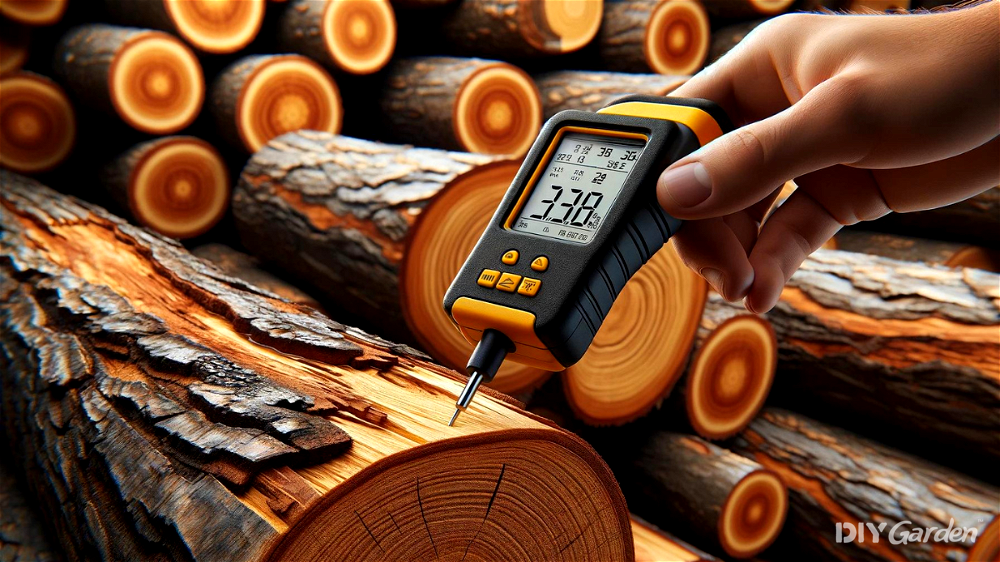
-
Best wood moisture meter - Brennenstuhl Moisture Detector
-
Best value for money - Dr.meter Digital Wood Moisture Meter
-
Best for multiple modes - Valiant Firewood Moisture Meter
Reviews
1. Brennenstuhl Moisture Detector[ SAVE 4% ]
Best wood moisture meter
- This moisture meter is compact and easy to grip - fitting comfortably in your hand
- The prongs are very strong and sturdy
- Can be used to detect the moisture in a range of building materials - including concrete, plasterboard and wallpaper
- The LCD display is large and clear
- Occasionally gives a different reading just a few millimetres away from the original, which has led to some users questioning its accuracy
- The LCD display needs to be held at the correct angle to read
- The on/off switch is exposed and it’s easy to turn it on accidentally
- Not a backlit display, so harder to read in dark areas
- Moisture Measuring Range
- 5 - 50%
- Number of Modes
- 2
- Number of Sensor Pins
- 2
- LED Screen
- Yes
- Weight
- 156g
- Accuracy
- 4.7
- Ease of Use
- 4.5
- Value for Money
- 4.6
Worrying about wet firewood? Not sure if your logs are ready for a clean burn in the stove? There’s no point in guessing. You need the best damp detector that you can get your hands on.
With a huge range of seriously clever electronic equipment from smart home appliances to engraving machines, German engineering firm brennenstuhl are a trusted name in the industry.
Simple to use, hugely versatile, and surprisingly accurate, the Brennenstuhl damp detector MD is a one-stop shop for checking the moisture content of firewood, walls, soil, concrete, brick, and almost anything else around the home and garden.
What Does it Do?
There are several different types of moisture meter, and the brennenstuhl one is a dual probe pin-type meter. Simply put, the device runs an electrical current between its probes, and the resistance that the material gives relates to the moisture level inside.
Using clever calculations, this device can tell the measure the damp levels of different materials. On top of wood, you can also measure concrete, tile, screed, plaster, carpets, and other building materials. You can even use it to test the moisture levels in your potting soil.
How I Tested the Brennenstuhl Damp Detector MD
To find out how well this little device dealt with damp, I tested it out on fresh cut wood, seasoned timber, and an assortment of building materials around the home and garden. Using well-seasoned oak from my loft that I knew would be bone dry, and freshly cut wood from a tree that was sopping wet, as well as a range of other woods, I got a good idea of how the machine ran.
Quick Guide
Although there are plenty of useful features on this damp detector, if you just want a quick and easy guide to detecting the moisture content in your firewood, here’s how it works:
- Press and hold the power button until the device beeps.
- Remove the protective top cover and replace it on the bottom of the detector.
- Push the pair of detector prongs into your target piece of wood
- Wait for the noise- slow beeps mean dry wood, fast beeps mean wet wood.
- Check again on different sections of the wood for a more accurate reading.
- Press and hold the power button to turn off the meter.
- Take the protective top cover off the bottom and replace it on the top.
Clever Features
If you want to “freeze” the current reading on the LCD screen, you simply press the button with a key on it. This is handy if you’re reaching to take a reading and can’t see the screen, or you want to remember a specific reading.
To get an accurate reading from soft materials like soil, you can push the pair of probes all the way in. Otherwise, you’ll only get a surface reading.
And if the loud beeps start to get on your nerves and you’d rather look at the LCD display for your moisture readings, you can turn off the noise.
If you’re at all serious about seasoning your firewood ready for the colder seasons, a moisture meter is an incredibly handy and rather inexpensive tool to add to your kit. And because it doubles up as a damp detector for building materials, it could solve other problems around the home.
Did you find this review helpful?
2. Dr.meter Digital Wood Moisture Meter[ SAVE 7% ]
Best value for money
- A good compact size that’s easy and comfortable to hold
- Comes with a handy storage pouch and batteries included
- Offers consistent, accurate readings so it’s easy to detect changes in moisture content
- Large and easy to read display
- Although the prongs are sharp, they cannot penetrate very hard wood
- There is no backlight so reading the display in dingy or dark areas may be tricky
- The on/off button is sensitive so it’s easy to turn on accidentally
- Although this is easy to use, the instructions are lacking in information
- Moisture Measuring Range
- 5 - 40%
- Number of Modes
- 1
- Number of Sensor Pins
- 2
- LED Screen
- Yes
- Weight
- 116g
- Accuracy
- 4.7
- Ease of Use
- 4.4
- Value for Money
- 4.4
The Dr.meter Digital Wood Moisture Meter is one of the best moisture meters in in terms of value for money. This digital moisture meter has a range of features and is a reasonable price without compromising on performance.
It can be used to detect moisture levels in both wood and plasterboard, so whether you’re setting up a warming fire or testing building materials for damp, it’s suitable for a variety of uses.
The moisture meter unit has two stainless steel pins, with a measurement range of 5 – 40%. It records a precise measurement, being accurate to ±1%. This is a good level of accuracy for domestic moisture meters. The moisture meter has an easy-to-read LCD display which is large enough for weaker eyes; however, it’s worth noting that this is not a backlit display, so it will be harder to read in dark areas.
The moisture detector is powered by a 9V battery which is included. There is also a low battery indicator, so you’ll know when to change it. These aspects definitely set this product apart from the others on my list, as it’s rare to find a moisture meter with a battery included.
This moisture meter is easy to operate and comes with a user guide, which explains what the moisture readings mean. As a result, this model is very user-friendly. This, combined with its cheaper price tag, makes it one of the best moisture meters for domestic use.
This moisture meter features a carry pouch and two spare pins, as well as a bright orange protective cap which is easy to spot. These included additions further increase its value for money – not all units come with spare pins (the Brennenstuhl Moisture Detector doesn’t).
This is an easy-to-use tool that offers great value, especially as it comes with spare pins and a battery. So, overall, this is one of the best meters in terms of value for money.
Did you find this review helpful?
3. Valiant Firewood Moisture Meter
Best for multiple modes
- Well constructed and sturdy
- Clear screen that’s easy to read at a glance
- There are 4 separate modes which can be used for different types of wood
- Comes with a small pouch for easy storage
- Need to scroll through to Mode 3 (for most types of wood) every time the device is turned on
- The prongs are fairly easy to bend when this meter is inserted into hard wood
- Larger and bulkier than other moisture meters on the market
- There’s no backlit display
- Moisture Measuring Range
- Not listed
- Number of Modes
- 4
- Number of Sensor Pins
- 2
- LED Screen
- Yes
- Weight
- 140g
- Accuracy
- 4.4
- Ease of Use
- 4.3
- Value for Money
- 4.4
All types of tree are different. So, to get the most accurate readings you’ll need a moisture meter that can base its reading depending on the specific wood species.
For this reason, the Valiant Firewood Moisture Meter is the best moisture meter for displaying accurate moisture levels in different tree species. It can be used to measure moisture in firewood and timber, including flooring, beams and joists.
The unit is well constructed and sturdy, with an easy-read screen.
There are four different modes on this digital moisture meter, suitable for different wood species. This is a handy function for a knowledgeable woods-person as you’re more likely to be handling a variety of wood types.
If you do not know the wood species that you are testing, the instructions recommend using mode 3, as many species of wood fall into this category.
To help with battery saving, the moisture meter will automatically turn off after a period of inactivity. It also has a low battery indicator. These features can be super helpful if you’re going to be using your moisture meter a lot, as you won’t want to be caught without a spare battery when you need one.
If you are knowledgeable about the type of wood you are testing, this could very well be the best moisture meter for you, as it gives very accurate results when used properly. However, if you’re looking for a simple model, there are more easy-to-use moisture meters available.
Did you find this review helpful?
Product Tester
Compare Product Features
Use the dropdown to sort the table by the feature you want to see.
Brennenstuhl Moisture Detector
- 4.6
- 5 - 50%
- 2
- 2
- Yes
- 156g
Dr.meter Digital Wood Moisture Meter
- 4.5
- 5 - 40%
- 1
- 2
- Yes
- 116g
Valiant Firewood Moisture Meter
- 4.4
- Not listed
- 4
- 2
- Yes
- 140g
How to Choose The Best Wood Moisture Meter
A wood moisture meter is a handheld device that will accurately measure moisture levels in wood. Moisture meters will help you identify the best firewood to burn, so less of it goes to waste.
These devices also help you burn firewood safely. There are some risks that come with burning firewood that is too wet or too dry, as you’ll see below.
As well as being useful for firewood, moisture meters are also a handy purchase for anyone who works with wood frequently. They can be used on various wood materials whether it’s for DIY, professional use or carpentry.
Most moisture meters aren’t exclusively for wood material either; some can measure the dampness of other building materials including brick, stone and fabrics.
There are various features across models, so if you’re looking for the best wood moisture meter but you’re not sure where to start, the following tips will help you make an informed decision:
READ NEXT: The Best Log Splitters
The Benefits of Using a Wood Moisture Meter
These tools have a wide range of helpful uses.
When it comes to firewood, the moisture content must be below 20% for it to burn well. If you burn wood wetter than this, it can cause problems.
Burning wood with a high moisture content can cause soot and tar to build up in a chimney, which has sometimes been known to cause house fires. Wet wood also releases a lot more smoke than dry wood, which can unpleasantly fill your living room.
Meanwhile, burning wood that is too dry can create a fire which is hard to control. So, using a wood moisture meter will help you get your fire to a moderate and ideal burn.
Whether you’re selling wood that you’ve cut, or just checking what you’ve got in your stores, having a moisture meter helps identify which wood will burn effectively.
If you sell firewood, customers will want to know its moisture content, so it’s great to be able to provide this figure.
If you often work with wood, either professionally or as a hobby, measuring moisture levels is important for safety reasons. Checking for damp in a wooden structure, timber beams, and plenty of other materials is a crucial stage in the construction process.
Some meters can be used for measuring moisture in other building materials as well as wood, such as stone, plasterboard and even carpet. This can be helpful when surveying a house, checking for mould, or preparing for construction.
Measuring Various Materials
The first thing you’ll need to think about is what you’re using the moisture meter for.
Some moisture meters only measure moisture levels, whilst others also read the humidity and air temperature. These features can indicate whether your log storage area is suitable, as well as checking the dampness of the wood itself.
If you’re only looking for a simple tool which can read moisture content and tell you if the logs you have are ready to use, then a basic moisture meter will be sufficient. It’ll only need to have one mode and take accurate moisture readings.
However, if you want more of an all-round tool, you’ll find that the best moisture meters are also able to take moisture readings from brick, plasterboard, textiles, and other materials. Plus, as mentioned, some can reveal information about the dampness in the air.
These units are particularly useful when doing DIY or assessing building structures.
Some wooden moisture meters, will have different modes for different species of tree. This mode is really only helpful if you’re an expert in wood but does offer a more specific understanding of moisture content.
READ NEXT: The Best Log Splitting Axes
Pinless Moisture Meters
If you’re using the moisture meter for DIY instead of testing firewood, you might want a pinless moisture meter.
Instead of requiring two metal prongs to be pushed into the wood, pinless moisture meters use electromagnetic wave technology to measure the wood’s moisture level.
This means that a pinless moisture meter won’t mark the wood, which is useful if testing wood that will be on display – like shelving and doors.
One of the drawbacks of pinless moisture meters is that they show the moisture levels over a vague area. Pin meters, on the other hand, measure a specific spot and are sometimes considered a more accurate meter.
Measuring Moisture Content
For firewood to burn well, its moisture content should be below 20%. To check its moisture levels, you’ll need a meter that can go up to at least 20%, so you know when a log is too wet to burn.
If you dry your own wood, a moisture meter that can take a reading of freshly cut wood will allow you to estimate when it might be ready to burn. In these cases, a larger moisture range will give you more information. Look for moisture meters range that from 5 to 40%.
If the meter is detecting moisture levels under 10%, there’s a risk that the wood is too dry. This could result in a fire that burns too quickly, and is hard to control. The further the value is under 10%, the bigger this risk becomes.
Experts recommend burning your firewood when its moisture content is between 10 and 20%.
Helpful Extra Features
There are a few functions that slightly improve moisture meters, but they aren’t essential:
- An automatic turn off feature will help your meter’s batteries last longer. Tools with this function will tend to turn themselves off after a few minutes of inactivity.
- A hold function will save the reading on the screen. This avoids the frustrating scenario of having crawled into an awkward place to take a reading, and then finding that the reading has disappeared before you’ve managed to wiggle out and check the screen. It also comes in handy when checking poorly lit areas.
- A moisture meter that beeps when it takes a reading can be extremely useful to people with a damp problem. Some products, like the Brennenstuhl Moisture Detector, will beep faster when it registers a higher moisture content.
- Some of the best wood moisture meters have brightly-coloured lids, so you can always spot them, and some come with spare replacement pins and carry cases.
Accuracy Percentage
Some moisture meters are more accurate than others. I recommend looking for a meter with at least an accuracy of around 1% each way.
Some of the more high-end moisture detectors are accurate to approximately 0.1%. These are only required for professional work.
Accuracy can also be improved by making sure you use the moisture meter on the most suitable setting. For example, if it has functions for different wood types, you’ll get a more accurate reading by setting it for the specific type of wood you’re testing.
Cheaper models will not be able to match the accuracy of higher-quality meters, but they still give valuable insight. The best advice is to check the reviews of anything you’re thinking of buying, to see how its performance has been rated by users.
Wood Moisture Meter FAQs
To burn firewood effectively, either in an open fire or a wood burning stove, the moisture percentage needs to be less than 20%. Freshly cut timber has a moisture content of between 30% and 60%, depending on the tree species and its growing conditions.
As well as burning poorly, wet firewood will produce lots more smoke than dry wood. So, burning wet wood can create an unpleasantly smoky room. In extreme cases, the conditions caused by burning wet wood has led to house fires.
Burning wet wood is less effective than burning dry wood, so you’ll end up using more of it. Using a digital meter to measure moisture content before setting up a fire can ultimately save you money, as you won’t be wasting wet wood.
Lastly, if your firewood is extremely dry, it will burn very quickly. Plus, dry fires can get out of control quite quickly. So, it’s worth making sure the wood’s moisture content is right.
Pinless moisture meters are your best bet if you don’t want to create holes in expensive wood.
The circuit inside a pinless moisture meter sends a signal in the form of electromagnetic waves. The waves create an electromagnetic field over the area underneath the pinless moisture meter’s sensor. The moisture content is calculated from the signal received in return.
Although a pinless moisture meter is often more expensive than a traditional pin meter, they provide a damage-free, reliable reading on smooth wood.
If firewood has a high moisture level (above 20%), it won’t burn well. The wood won’t catch alight properly, burn efficiently or generate much heat. You’ll also end up with a fire that produces a lot of smoke, and it could cause dangerous tar build up in the back of the chimney.
If the moisture of your firewood is too low, it burns too quickly. Plus, wood that is too dry can produce a fire which is hard to control. A small amount of moisture is needed to moderate the burn rate.
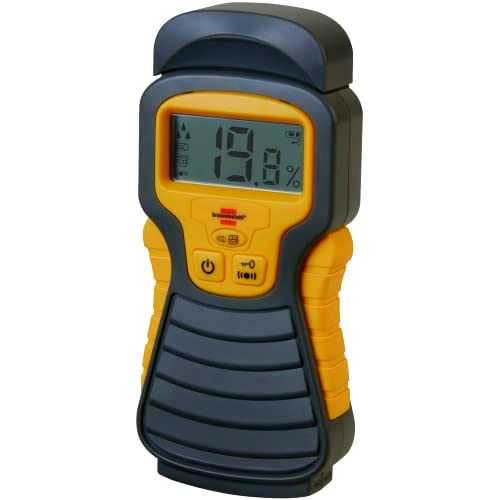
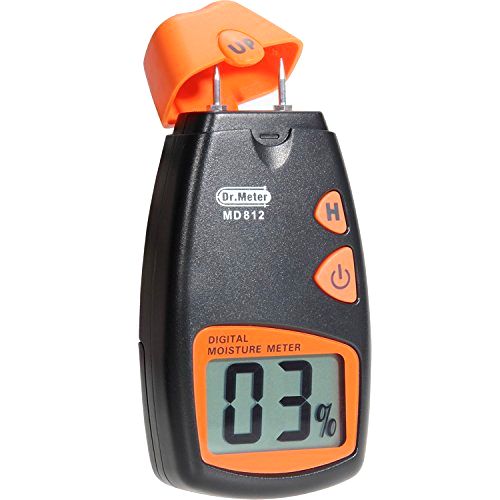
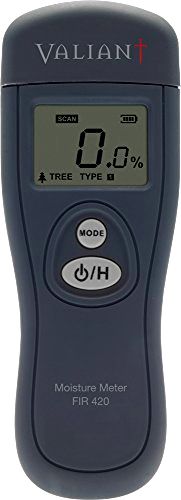
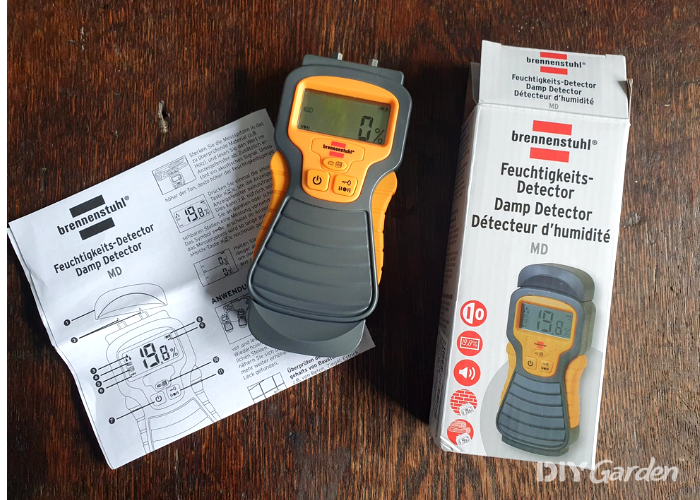

Share